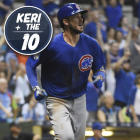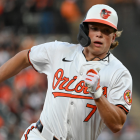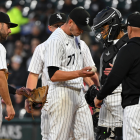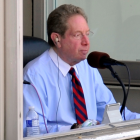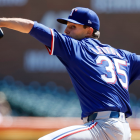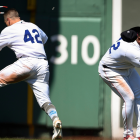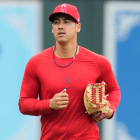 Two rookies set a historic home-run pace, two more homer records go Bye Bye, a streak for the ages gets broken, and some old friends are up to some old tricks.
Two rookies set a historic home-run pace, two more homer records go Bye Bye, a streak for the ages gets broken, and some old friends are up to some old tricks.
It’s the penultimate 2017 regular-season edition of #KeriThe10.
1. They're baaaaack
They broke the longest championship drought in North American sports history in breathtaking fashion. They limped to a slow start, getting outclassed by heavy underdogs instead of taking command of the NL Central the way everyone expected.
Now, finally, the Cubs are back. They own the best record in the National League since the All-Star break (42-22), they're back in prime position to win their division (leading by 4 1/2 games), and most of their key players look like their old, excellent, 2016 selves.
Anthony Rizzo and Kris Bryant have been the sixth- and seventh-best hitters in the National League in the second half. Willson Contreras is back off the disabled list, hitting a ludicrous .320/.421/.670 since the break. Kyle Schwarber, who looked like he'd had his hitting powers stolen in a Space Jam-esque caper early in the season, is slugging .558 with a team-leading 15 homers in the second half. Meanwhile, Javier Baez is slugging .515 with 12 homers since the break, combining those numbers with his elite defense to make him one of the most exciting players in the league. The team with the best overall park-adjusted offense since the break? You guessed it, Frank Stallone. (It's the Cubs.)
The Cubs' season, and their shot at going back-to-back, might ultimately rest on their starting pitching. Kyle Hendricks posted a microscopic 2.13 ERA last year thanks to a combination of excellent command plus some luck with men on base...only to see that ERA balloon by nearly two runs in the first half of this season when some of that luck ran out...only to have that same combination of precision pitching and good fortune net a 2.42 ERA after this year's All-Star break. Jake Arrieta also returned to his old ace form in the second half following a spotty start to the season, flashing a 1.97 ERA since the break; he made his return from a hamstring injury Thursday night, and tossed five innings of one-run ball against Milwaukee to help give the Cubs some vital breathing room in the NL Central race.
So really, the season may well come down to Jon Lester. After a lights-out 2016, the veteran southpaw is sitting on his highest ERA in five years, his highest walk rate in six years, and his highest home-run rate in a decade. Lester hit the disabled list in late August following a nine-run debacle against the Reds, only to return in early September to another round of lousy results: a 5.91 ERA and an opponents' batting line of .321(!)/.412(!!)/.536(!!!) in his past four starts, including a seven-run meltdown Wednesday at Tropicana Field.
After that awful start against the Rays, Lester Tweeted that he wasn't hurt, just struggling with command and consistency. Still, as strong as the rest of the team has looked lately, don't be surprised if Joe Maddon deploys his infamously quick playoff hook if Lester can't answer the bell. Few would have expected the team's $155 million to be its biggest source of concern on an otherwise impressive hot streak, but with 10 days left before what'll likely be another division crown, that's where we are.
2. Matt Olson, human fireball
The A's rookie slugger has been surface-of-the-sun hot this season, especially lately. Here are five eye-popping facts that stand out about the American League's second-half version of Aaron Judge.
-- Jose Canseco ranks third in franchise history for most home runs in the first 65 games of a career by an A's rookie, with 16. Tied for first: Mark McGwire and Matt Olson, with 22 each.
-- Olson has now hit 46 home runs this season in 135 games -- 23 with Triple-A Nashville, 23 with the A's.
-- Olson is the first rookie in major league history to swat 15 homers over a 21-game span.
-- Olson has hit 12 homers in his past 17 games, eight in his past 11, and five in his past six.
-- Stats Inc. recently offered up a terrific comparison of all-time sluggers. Here are the all-time leaders in fewest at-bats per home run, minimum 150 plate appearances:
Babe Ruth 11.8
Cody Bellinger 11.5
Mark McGwire 10.7
Matt Olson 7.78
Rhys Hoskins 7.77
3. Break up the Phillies!
The races for the final wild-card spots in each league aren't the only tight battles happening in the final days of the season. The battle for the number-one pick in next year's amateur draft is also exceptionally close, with the Giants, White Sox and Phillies separated by just one game in the standings. For that, the Phillies can thank an impressive recent hot streak, and what might be the first glimpse of an exciting, up-and-coming team.
The Phils have won seven of their past 10 games, including a three-game sweep of the Marlins and an impressive three out of four against the Dodgers. And while anything can happen in a small sample of games, we're starting to see signs of what the Phillies could become, maybe in the near future.
Hoskins has hogged a lot of the headlines, rightfully so with that record-setting home-run pace he's been on to start his career. But what we're seeing lately isn't just the Rhys Hoskins Show. The Phils have produced the National League's third-best offense in September by park-adjusted metrics. Twenty-four-year-old rookie outfielder Nick Williams is hitting over .300 with impressive extra-base pop this month. Twenty-two-year-old rookie shortstop J.P. Crawford has shown a patient batting eye since his September 5 major league debut, building on his ability to draw walks and work deep counts that he displayed throughout much of his minor league career; he's also flashed an impressive glove, and done so out of position at third base to boot. The pitching staff isn't as deep in young, premium talent yet, but Aaron Nola's breakout season (26.2 percent strikeout rate, park-adjusted ERA 18% better than league average, park-adjusted fielding-independent pitching 27 percent better than league average at age 24) offers hope that the team's ace might've already arrived.
Plenty of other pieces would still have to fall into place for the Phillies' rebuild to gain steam. But you never know how fast top prospects might blossom, and Philly has a handful all starting to earn their stripes already. After the leaps and bounds made by 2016 also-rans in Colorado, Arizona, Minnesota, and Milwaukee this season, you can't help but wonder: Could next year's Cinderella story be showing its first signs of life right here, right now?
4. The Royals' single-season home-run record goes Bye Bye
After 32 years, someone has finally surpassed the powder blue-donning legend, Steve "Bye Bye" Balboni. That would be Mike Moustakas, who blasted his KC-record-setting 37th homer of the season, topping the 36 that Balboni hit back in 1985.
Bye Bye himself had a delightfully charming salute for the Moose.
Steve Balboni has a special message for the new #Royals home run champion. #RaisedRoyal pic.twitter.com/S9hRufz9uB
— Kansas City Royals (@Royals) September 21, 2017
5. Here's one more home-run mark that vanished this week
After going 287 major league starts without allowing one, Clayton Kershaw finally served up the first grand slam of his career. The Phillies' Aaron Altherr did the damage on Monday night... but honestly, even if it was Mike Trout, or Babe Ruth, or Barry Bonds at the absolute height of his powers, it still would've come as a shock.
Read Jeff Sullivan's terrific account of the moment that still seems impossible to believe. Then consider this: Even counting that Altherr blast, opponents have hit .202/.242/.292 against Kershaw with the bases loaded, with a grand total of just six extra-base hits...as he nears the end of his 10th season in the big leagues.
Randy Johnson better watch out. We might be watching his eventual replacement for the title of best left-handed pitcher in baseball history.
6. Kevin Kiermaier, still ridiculous
Is that Superman? Nope, just @KKiermaier39.
— #Statcast (@statcast) September 16, 2017
The #Rays Gold Glover strikes for another 🌟🌟🌟🌟🌟 play, converting an 18% catch probability. pic.twitter.com/89CoJUZ9GB
7. Trevor Bauer, not great with 22-game winning streaks
First, the right-hander lost a game in 2010 for UCLA after the Bruins had won their first 22 games of that season. Then, he took the loss for Cleveland last Friday, snapping the club's American League record-setting 22-game win streak. Bauer was disarmingly self-effacing about the whole thing, suggesting that maybe the next team to reach the 22-in-a-row mark should "have someone else pitch for 23."
No apologies necessary, though. Even after last week's loss, Bauer's still on one of the hottest streaks of his career. His numbers over his past 11 appearances? 65 innings, 72 strikeouts, and a 2.63 ERA. One of the most ardents students of pitching in the game, Bauer's simply outthinking and overmatching hitters lately, making himself one of many big reasons why Cleveland heads into the postseason on a hot streak for the ages. Twenty-three or not, one rough outing at the wrong time notwithstanding, watching Bauer pitch lately has been glorious.
Trevor Bauer, 3 pitch K Sequence (all curveballs). pic.twitter.com/5cadjW3mkY
— Rob Friedman (@PitchingNinja) September 11, 2017
8. Tip of the cap for a standing O...
...by Cleveland fans, who not only cheered like mad through all those 22 wins in a row, but also warmly serenaded their team even after the streak was broken.
What a ride!
— SportsTime Ohio (@SportsTimeOhio) September 16, 2017
The @Indians' win streak ends at 22 but they provide us with an unforgettable Cleveland story. #RallyTogether pic.twitter.com/bkCyIhMedJ
9. Zack! Zack! He's a pitching maniac
The Diamondbacks have engineered one of the greatest year-to-year pitching turnarounds by any team in recent history, making them a dangerous threat in October if they can get through the NL wild-card game. The reemergence of Zack Greinke as an unquestioned ace this season (following a disappointing 2016 campaign), has been a big reason for Arizona's success. Our resident ace pitching analyst, Nick Pollack of PitcherList.com, has the details on what's made the Greinke of 2017 look a lot like the world-beater of 2015:
The 2016 season was a rough one for Zack Greinke. After signing a $206 million deal with the Diamondbacks, his first season in the desert returned a mediocre 4.37 ERA with just 134 strikeouts, following a killer 2015 effort in which he punched out 200 batters and flashed a tiny 1.66 ERA. Clearly something changed, and before we look at 2017's success, we need to understand what went wrong in 2016.
We can point to an oblique injury that limited him to 26 starts, possibly affecting his performance at times when he pitched too. We can also consider his release point fluctuating across starts, making it tougher to mask pitches and locate pitches consistently. Diving deeper into specifics, the biggest area of improvement for Greinke from last year to this year has been his four-seam fastball.
In 2016, Greinke's four-seamer allowed a huge .316 batting average, a massive .264 isolated power mark, and a .940 OPS. Those are terrible numbers, especially when you consider that Greinke's four-seamer induced a sub-.200 batting average in 2015. There are many variables that could cause diminished fastball performance – switching from Dodger Stadium to a home ballpark known for being the most hitter-friendly except for Coors, for one. Still, the much of it simply comes down to location.
Take a look at Greinke's four-seamer heatmap for 2016:
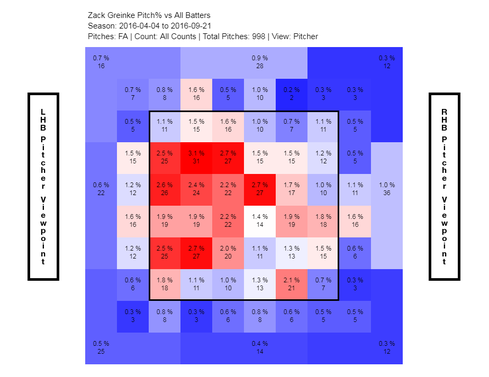
Notice how often pitches are located in the top-left quadrant, and how few are in the bottom half of the zone. What normally happens when pitches are placed higher in the zone? Logic would suggest batters would hit more fly balls, while increasing their home-run counts. And that's exactly what happened.
Greinke gave up fly balls 41.5 percet of the time with his four-seamer in 2016 (the first time that had happened in four years), allowing an ugly 1.3 home runs per nine innings -- his worst home-run rate in a decade.
So Greinke had a terrible fastball in 2016, but did he make a change with the pitch in 2017? Well, let's look at his four-seamer heat map for 2017:
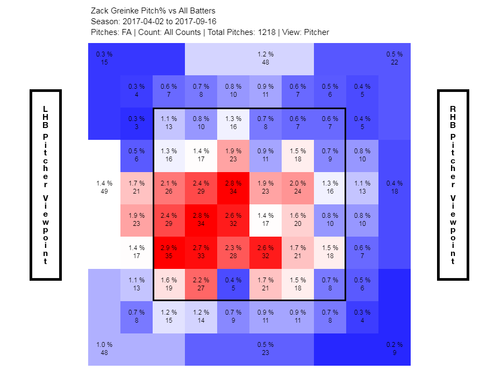
There's a major shift lower in the zone here, so much so that Greinke has rarely elevated the pitch in the upper half of the zone at all. The results have followed: 33.7 percent flyball rate, .257 batting average, and a .747 allowed OPS allowed against the fastball, with a sharply higher groundball rate to boot. Looking at his overall numbers, we see that his inflated 1.3 HR/9 IP mark of 2016 has dropped to 0.97 per nine innings this year, with his ERA diving by a run and a half
Establishing a better fastball can work wonders across the board. By getting ahead with a better pitch, Greinke's slider and changeup have improved as well, both increasing their whiff rates (20.8 percent to 26.5 percent and 15.7 percent to 16.5 percent, respectively). An improved heater has also helped reduce the number of free passes issued, bringing Greinke down to the third-lowest walk rate of his career.
As the Diamondbacks prepare for a wild-card matchup, they will look to Greinke to lead their team to the division series. With his improved fastball precision, he looks ready to take on the challenge.
10. Burning Question of the Week
Who leads the NL in fWAR? #KeriThe10
— Washington Nationals (@Nationals) September 21, 2017
The correct answer is Anthony Rendon! And this is a great segue into a fascinating NL MVP race. Consider these stat lines:
Anthony Rendon: .303/.402/.538, 143 wRC+, 6.7 WAR (per Fangraphs)
Joey Votto: .316/.451/.575, 164 wRC+, 6.3 WAR
Giancarlo Stanton: .279/.378/.634, 158 wRC+, 6.4 WAR
Charlie Blackmon: .329/.395/.602, 141 wRC+, 6.2 WAR
Paul Goldschmidt: .305/.410/.576, 147 wRC+, 5.5 WAR
Nolan Arenado: .306/.370/.580, 127 wRC+, 5.2 WAR
That list doesn't include Max Scherzer and other pitchers, plus a handful of other position players who've turned in all-around excellent performances this year. But the bottom line is this: Biased or not, the Nationals are right to shine a light on Rendon as an excellent MVP candidate. It's just that the field is so extraordinarily crowded this year, we're going to need every last at-bat from now to the end of the season to better gauge the best choice... and even that might not do anything to make the picture any less murky.













